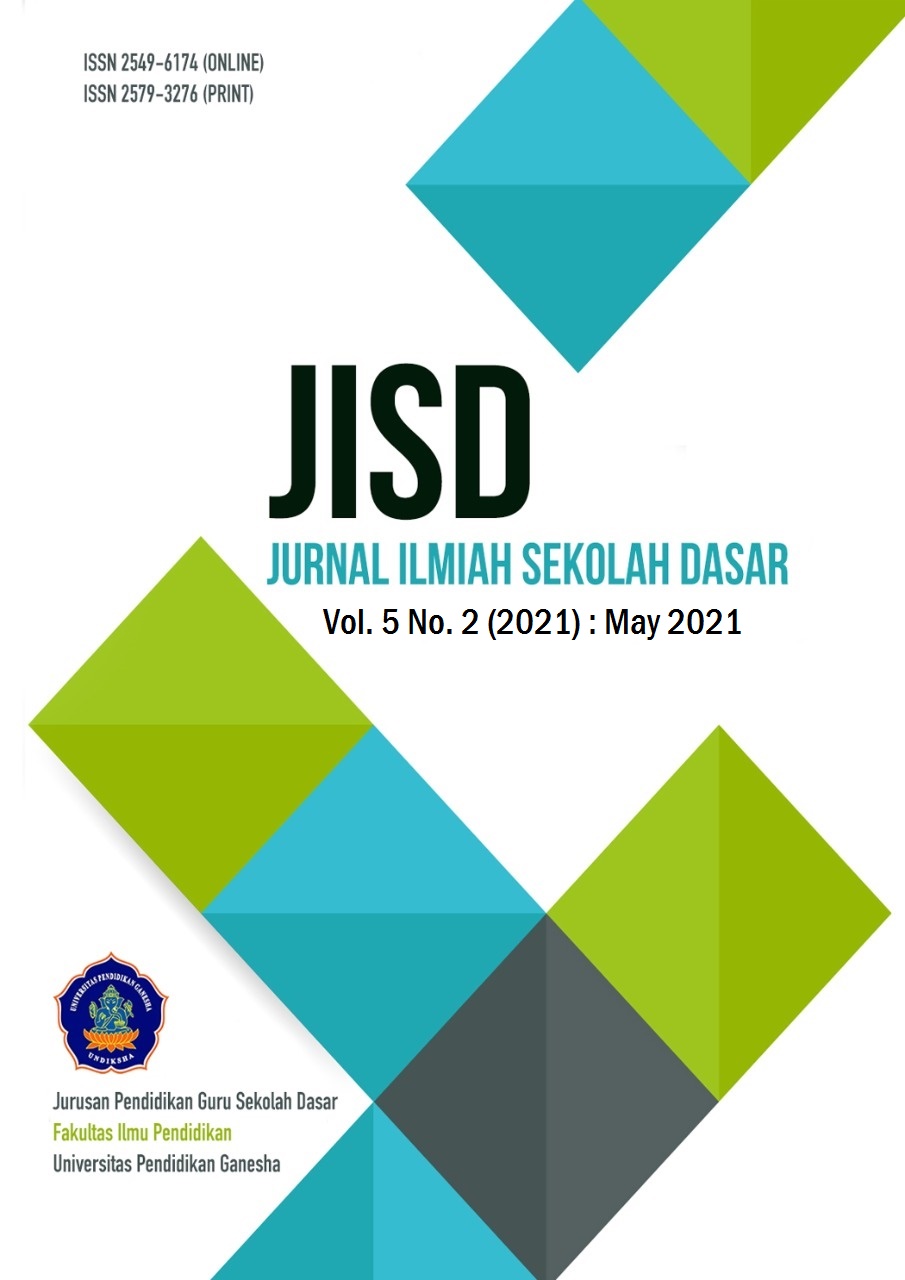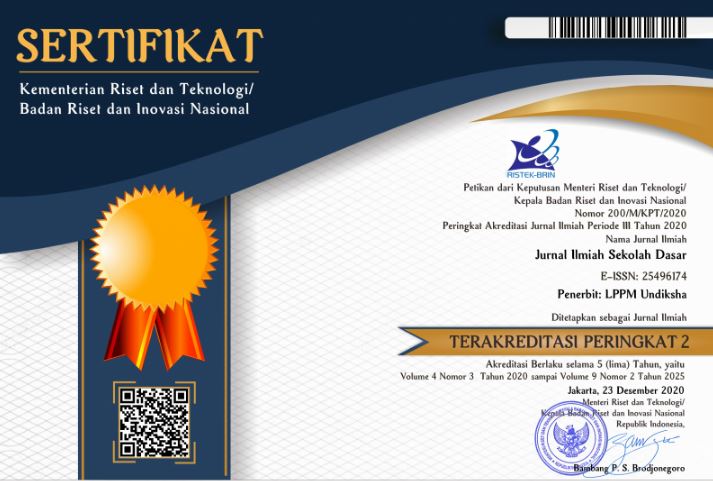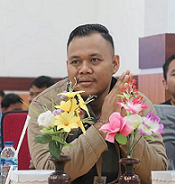Digital Student Songbook as Supporting Thematic Teaching Material in Elementary School
DOI:
https://doi.org/10.23887/jisd.v5i2.36952Keywords:
thematic learning, music education, digital songbook, interactive multimediaAbstract
The industrial revolution 4.0 and 21st-century skills leave fundamental problems in the implementation of 2013 curriculum teaching materials with an integrated thematic approach, including learning the art of music in elementary schools. It is very important for teachers to integrate technology into learning. The purpose of this research is to develop interactive multimedia in the form of a digital songbook as a support for integrated thematic teaching materials. The type of research that has been used is Research & Development which refers to the ADDIE. The subjects of this study were 4 (four) teachers and 100 elementary school students in the city of Padang. Data collection techniques and instruments were in the form of a questionnaire consisting of a validation questionnaire for validators and a practicality questionnaire given to teachers and students. The data analysis technique was obtained by taking the average results of product validation and practicality. The results showed that the average score of content and graphic validation was 84.1% in the appropriate category, while the average practicality score was 86.7%. Thus, the Digital Song Book is feasible and practical to use in learning the art of music as a support for integrated thematic teaching materials in elementary schools that meaningful for elementary students. The findings of this study have significant implications for designers and teachers, as well as multimedia researchers.
References
AACTE & P21. (2010). Teachers for the 21st Century. In AACTE & P21 (Issue September). https://doi.org/10.1787/9789264193864-en.
Alaloul, W. S., Liew, M. S., Zawawi, N. A. W. A., & Kennedy, I. B. (2020). Industrial Revolution 4.0 in the construction industry: Challenges and opportunities for stakeholders. Ain Shams Engineering Journal, 11(1), 225–230. https://doi.org/10.1016/j.asej.2019.08.010.
Alismail, H. A., & McGuire, P. (2015). 21 St Century Standards and Curriculum: Current Research and Practice. Journal of Education and Practice, 6(6), 150–155.
Ananiadou, K., & Claro, M. (2009). 21st century skills and competences for new millennium learners in OECD countries. In OECD Education Working Papers (Issue 41). https://doi.org/10.1787/218525261154.
Anggraeni, C. W. (2018). Promoting Education 4 . 0 in English for Survival Class : What are the Challenges ? METATHESIS Journal of English Language, Literature, and Teaching, 2(1), 12–24. https://doi.org/10.31002/metathesis.v1i2.676.
Ardipal. (2015). Kembalikan Lagu Anak-anak Indonesia: Sebuah Analisis Struktur Musik. Panggung, 25(4), 343–355.
Ardipal. (2020). Pemanfaatan Perangkat Teknologi Dalam Pembelajaran Musik Berbasis. Musikolastika: Jurnal Pertunjukan Dan Pendidikan Musik, 2(2), 77–84.
Budiyono. (2020). Inovasi Pemanfaatan Teknologi Sebagai Media Pembelajaran di Era Revolusi 4.0 Budiyono. Jurnal Kependidikan, 6(2), 300–309. https://doi.org/https://doi.org/10.33394/jk.v6i2.2475.
Coleman, E. G. (2010). Ethnographic Approaches to Digital Media. Annual Review of Anthropology, 39(1), 487–505. https://doi.org/10.1146/annurev.anthro.012809.104945.
Desyandri. (2012). The Usage of CTL Approach to Improve the Process and Learning of Singing to Studen Class III Elementary School. Jurnal Pedagogi FIP UNP.
Desyandri. (2018). Nilai-nilai Kearifan Lokal untuk Menumbuhkembangkan Literasi Budaya di Sekolah Dasar. Sekolah Dasar: Kajian Teori Dan Praktik Pendidikan, 27(1), 1–9. http://dx.doi.org/10.17977/um009v27i12018p001.
Desyandri, Mansurdin, Taufina, Arwin, & Tamara, Y. M. C. (2019). Analysis of the Mastery of the Nusantara Songs in 4th Grade Elementary School Students. Proceedings of the 5th International Conference on Education and Technology (ICET 2019), 382(Icet), 482–485. https://doi.org/10.2991/icet-19.2019.122.
Desyandri, & Maulani, P. (2019). Penerapan Model Project Based Learning untuk Meningkatkan Hasil Belajar Seni Musik Pada Pembelajaran Tematik Terpadu di Sekolah Dasar. Jurnal Inovasi Pendidikan Dan Pembelajaran Sekolah Dasar, 3(2), 58–67.
Dilfa, A. H., Maestro, E., & Putra, I. E. D. (n.d.). Buku Lagu Digital Anak Indonesia Ceria untuk Taman Kanak-kanak: Studi Pengembangan Media Audio-Visual. E-Journal Sendratasik, 6(2), 9–15.
Elfiona, E., Zaim, M., & Refnaldi. (2019). Mobile-Based Media as the Solution in Teaching and Learning Listening Skill. Journal of Physics: Conference Series, 1387(1). https://doi.org/10.1088/1742-6596/1387/1/012024.
Fauzan, F., & Arifin, F. (2019). The Effectiveness of Google Classroom Media on the Students’ Learning Outcomes of Madrasah Ibtidaiyah Teacher Education Department. Al Ibtida: Jurnal Pendidikan Guru MI, 6(2), 271. https://doi.org/10.24235/al.ibtida.snj.v6i2.5149.
Fauziyah, S., Tambunan, T. D., & Telnoni, P. A. (2017). Aplikasi Belajar Bernyanyi dan Menghafal Lagu-lagu Daerah Untuk Siswa Sekolah Dasar Berbasis Website. E-Proceeding of Aplied Science, 3(3), 1654–1665.
Gao, X. (2020). New Mode of Distance Learning in Primary Schools in the Environment of Multimedia Computer Assisted Instruction. Journal of Physics: Conference Series, 1544(1). https://doi.org/10.1088/1742-6596/1544/1/012031.
Gikas, J., & Grant, M. M. (2013). Mobile computing devices in higher education: Student perspectives on learning with cellphones, smartphones & social media. Internet and Higher Education, 19, 18–26. https://doi.org/10.1016/j.iheduc.2013.06.002.
Johnson, K., & Heiderscheit, A. (2018). A survey of music therapy methods on adolescent inpatient mental health units. Journal of Music Therapy, 55(4), 463–488. https://doi.org/10.1093/jmt/thy015.
Kadek, N., Riris, D., & Wibawa, I. M. C. (2021). Socio-Cultural Diversity in The Form of Digital Comics for Fourth Grade Students : Validity and Feasibility. 5(1), 87–95.
Lieung, K. W., Rahayu, D. P., & Yampap, U. (2021). Development of an Interactive E-book to Improve Student ’ s Problem Solving. 5(1), 8–15.
Malloch, S., & Trevarthen, C. (2018). The human nature of music. Frontiers in Psychology, 9(OCT), 1–21. https://doi.org/10.3389/fpsyg.2018.01680.
Mansurdin, Helsa, Y., & Desyandri. (2019). Primary School Teachers Problems in Implementation of Curriculum 2013. 5th International Conference on Education and Technology (ICET 2019), 382(Icet), 672–677. https://doi.org/10.2991/icet-19.2019.163.
Marjoni, I., & Indrapraja, D. K. (2016). Penggunaan Media Musik Sebagai Aspek Pendukung Dalam Pembelajaran Seni Budaya Di Smp. Jurnal Pendidikan Dan Pembelajaran, 5(1), 1–19.
Mayer, R. E. (2019). How multimedia can improve learning and instruction. In The Cambridge Handbook of Cognition and Education (pp. 460–479). https://doi.org/10.1017/9781108235631.019.
Miaz, Y., Helsa, Y., Desyandri, & Febrianto, R. (2018). Cartography in designing digital map using Adobe Flash CS6. Journal of Physics: Conference Series, 1088. https://doi.org/10.1088/1742-6596/1088/1/012069.
Muchlis, L. S., & Putra, F. K. (2017). Development of Mobile Learning Based- Interactive Multimedia in Programming Language Class At Stain Batusangkar. Ta’dib, 20(2), 72–84. https://doi.org/10.31958/jt.v20i1.673.
Nursuhud, P. I., Oktavia, D. A., Kurniawan, M. A., Wilujeng, I., Jumadi, & Kuswanto, H. (2019). Multimedia Learning Modules Development based on Android Assisted in Light Diffraction Concept. Journal of Physics: Conference Series, 1233(1). https://doi.org/10.1088/1742-6596/1233/1/012056.
Poth, R. D. (2019). Connecting Technology and Pedagogy. Journal of Digital Learning in Teacher Education, 35(3), 124–125. https://doi.org/10.1080/21532974.2019.1622916.
Primamukti, A. D., & Farozin, M. (2018). Utilization of interactive multimedia to improve learning interest and learning achievement of child. Jurnal Prima Edukasia, 6(2), 111–117. https://doi.org/10.21831/jpe.v6i2.19183.
Purnomo, A., Hartono, R., Hartatik, & Riasti, B. K. (2016). Pengembangan Aplikasi Info Lagu Nusantara Berbasis Android Untuk Melestarikan Warisan Budaya Indonesia. Jurnal SIMETRIS, 7(2), 527–536.
Rachmadtullah, R., Zulela, M. S., & Syarif Sumantri, M. (2019). Computer-based interactive multimedia: A study on the effectiveness of integrative thematic learning in elementary schools. Journal of Physics: Conference Series, 1175(1). https://doi.org/10.1088/1742-6596/1175/1/012028.
Sari, R. M. M., & Priatna, N. (2020). Model-Model Pembelajaran di Era Revolusi Industri 4.0 (E-Learning, M-Learning, AR-Learning dan VR-Learning). Jurnal Ilmiah Fakultas Keguruan Dan Ilmu Pendidikan, 6(1), 107–115. http://ejournal.unsub.ac.id/index.php/FKIP/article/view/699/591.
Schwab, K. (2016). The Fourth Industrial Revolution. World Economic Forum.
Sriadhi, Khaerudin, Wahyuningtyas, N., Darni, Zainul, R., Adri, M., Rusdinal, Nasrun, Rahmulyani, Nuranjani, Nurmaniah, Wedi, A., Surahman, E., Aisyah, E. N., Oktaviani, H. I., Sri Martini Meilanie, R., Purnamawati, S. N., Hapidin, Listyasari, W. D., … Adnan, E. (2020). Development of Moodle-based Content Learning System in MKDK Student Development Subjects at LPTK in Indonesia. Journal of Physics: Conference Series, 1594(1). https://doi.org/10.1088/1742-6596/1594/1/012021.
Widyaningsih, S. W., Yusuf, I., Prasetyo, Z. K., & Istiyono, E. (2020). Online Interactive Multimedia Oriented to HOTS through E-Learning on Physics Material about Electrical Circuit. JPI (Jurnal Pendidikan Indonesia), 9(1), 1. https://doi.org/10.23887/jpi-undiksha.v9i1.17667.
Downloads
Published
How to Cite
Issue
Section
License
Authors who publish with the Journal Ilmiah Sekolah Dasar agree to the following terms:
- Authors retain copyright and grant the journal the right of first publication with the work simultaneously licensed under a Creative Commons Attribution License (CC BY-SA 4.0) that allows others to share the work with an acknowledgment of the work's authorship and initial publication in this journal.
- Authors are able to enter into separate, additional contractual arrangements for the non-exclusive distribution of the journal's published version of the work (e.g., post it to an institutional repository or publish it in a book), with an acknowledgment of its initial publication in this journal.
- Authors are permitted and encouraged to post their work online (e.g., in institutional repositories or on their website) prior to and during the submission process, as it can lead to productive exchanges, as well as earlier and greater citation of published work. (See The Effect of Open Access)










